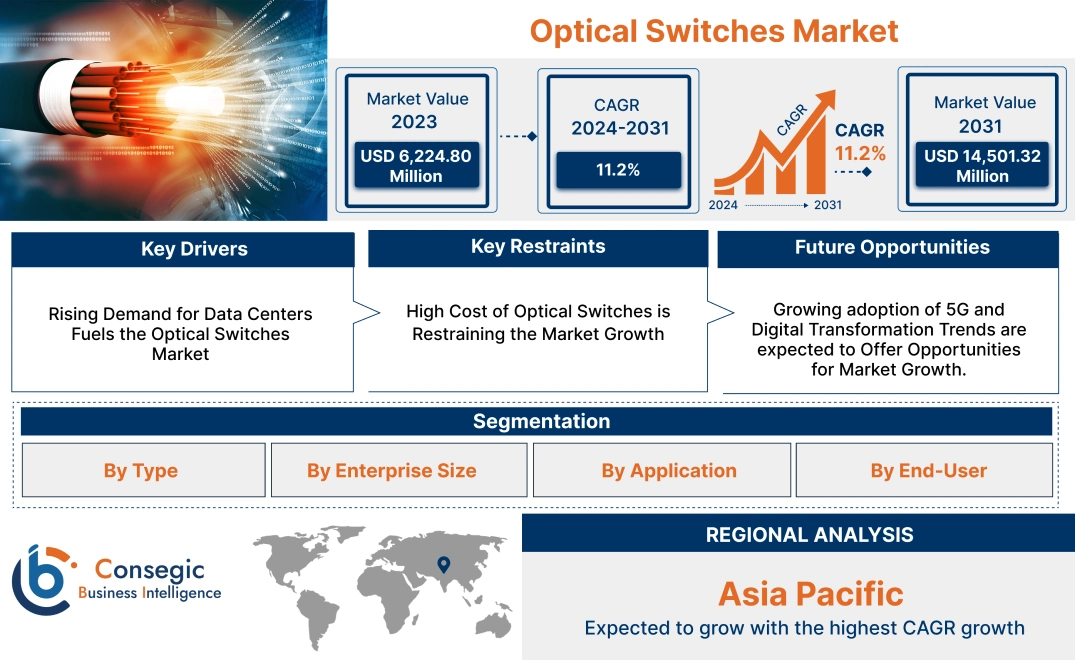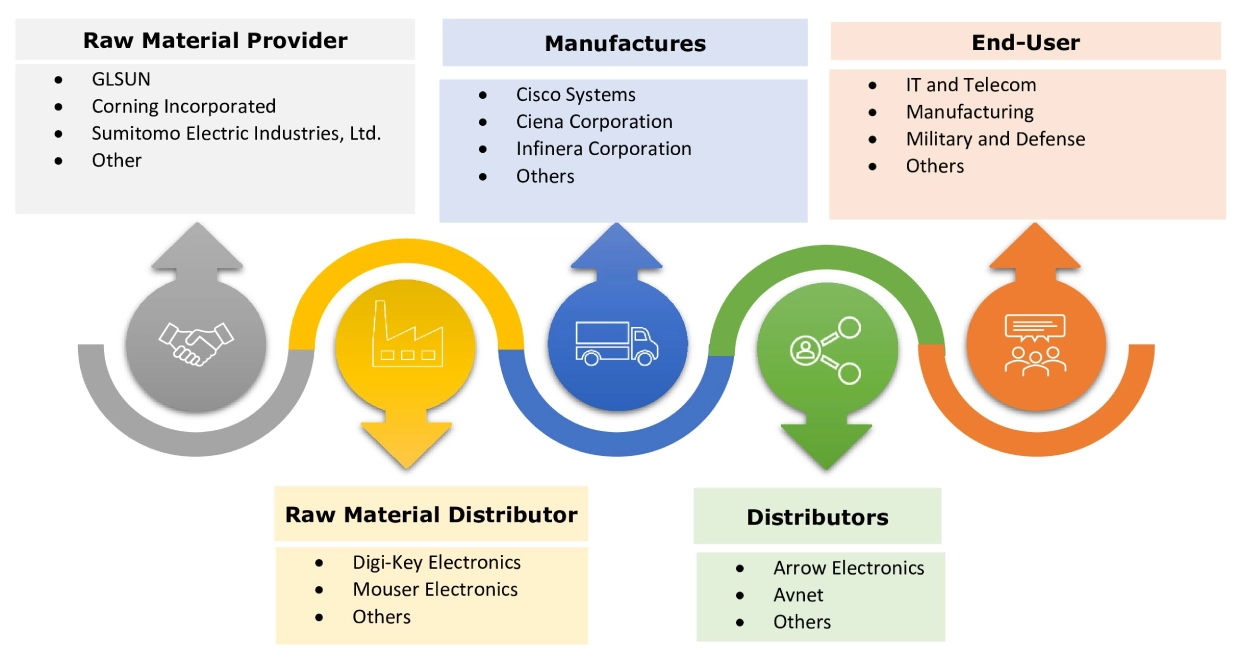- Summary
- Table Of Content
- Methodology
Optical Switches Market Size:
Optical Switches Market size is estimated to reach over USD 14,501.32 Million by 2031 from a value of USD 6,224.80 Million in 2023 and is projected to grow by USD 6,807.98 Million in 2024, growing at a CAGR of 11.2% from 2023 to 2031.
Optical Switches Market Scope & Overview:
Optical switches (OS) refer to a component of a communication network that is majorly found inside the network-connected devices. The optical switches have multiple ports for network bridges to connect multiple optic fibers to control data packet routing between inputs and outputs. Moreover, switches have the ability to convert light to electric data. Also, features include transmission of large amounts of data, high signal quality, energy efficiency, less power consumption, and others. Additionally, the advantages include high speed, low latency, minimal signal loss, and others which make them crucial for high-capacity networks. The end-user industries such as IT and telecom, BFSI, and manufacturing among others are driving the market adoption. Further, the surge in requirement for high bandwidth and data transmission rate is boosting the optical switches market size.
Optical Switches Market Dynamics - (DRO) :
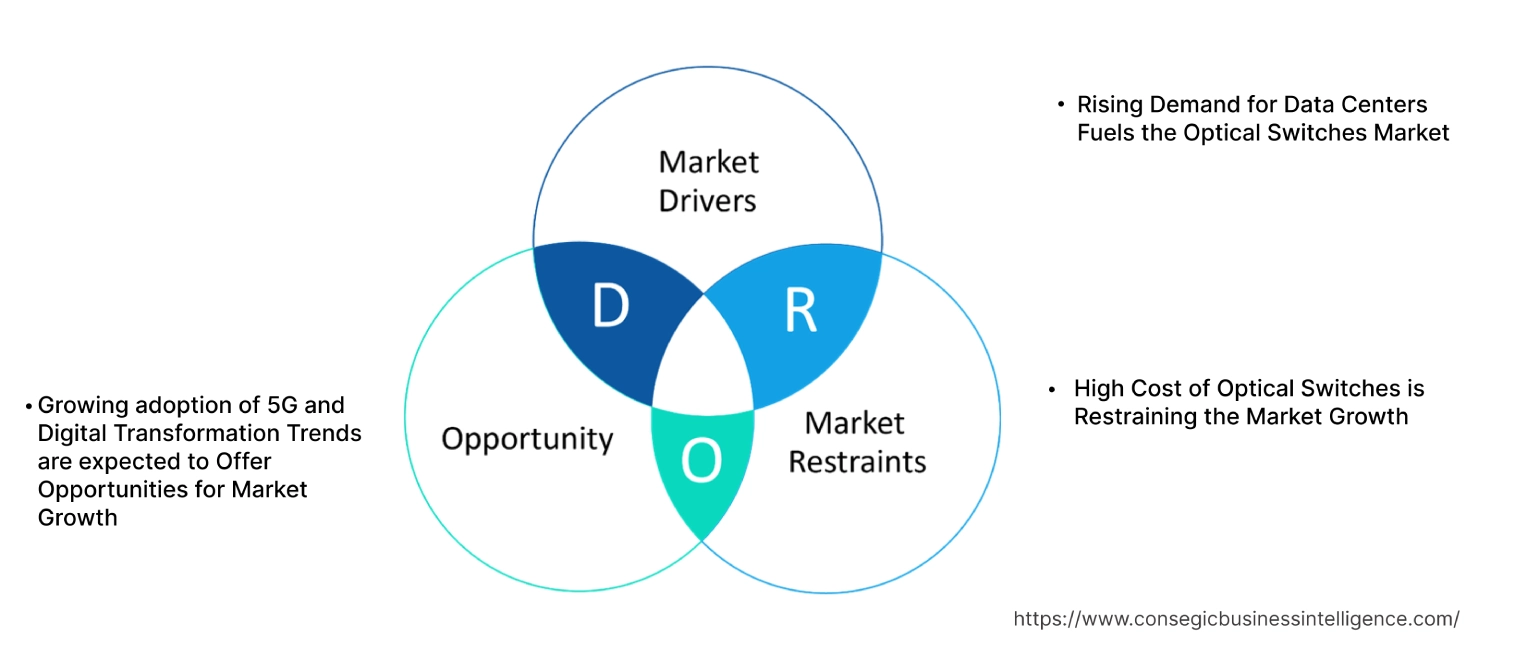
Key Drivers:
Rising Demand for Data Centers Fuels the Optical Switches Market
The primary factor driving the number of data centers is the increasing demand for cloud computing, data analytics, and an increasing number of connected IoT devices among others. Additionally, switches play a crucial role in data centers by seamlessly enabling high-speed data transmission and enhancing connectivity. Hence, increases the performance and reduces the latency in data transmission. Moreover, factors driving the adoption of data centers include high-speed data transmission, low latency, energy efficiency, scalability, and others. /p>
- In October 2023, NTT Corporation achieved a milestone of exceeding 1.6Tbit/s per fiber speed by transmitting/receiving optical signals with the help of an NTT-developed ultra-wideband amplifier. The achievement improves the scalability of the data center network by providing large-capacity transmission.
Therefore, the ability to transmit data at high speed with less latency is driving the demand in data centers which in turn propels the progress of optical switches market share.
Key Restraints :
High Cost of Optical Switches is Restraining the Market Growth
The major components of an optical switch including lasers, modulators, detectors, and amplifiers incur high costs. Additionally, high cost hinders the adoption in small and medium enterprises due to budget constraints. Further, the complexity in installation and integration with existing systems also incurs a huge amount of cost which is a significant restraint to the optical switches market expansion. The adoption is majorly in data centers and telecom industries and the cost of initial investment is huge which in turn is restraining the market evolution.
Therefore, the high costs are restraining the optical switches market demand.
Future Opportunities :
Growing adoption of 5G and Digital Transformation Trends are expected to Offer Opportunities for Market Growth.
The development of 5G networks is driven by the increasing use of IoT devices across industries, which require fast, reliable connections for real-time communication and data transmission. Moreover, optical switches have the ability to handle large volumes of data with minimal signal loss which is crucial for 5G networks which in turn drives the growth of the market.
- In August 2024, according to IBEF, the number of 5G base transceiver stations surpassed 450,000 after the launch of 5G services in India. Therefore, the proliferation of 5G infrastructure is promoting market adoption.
Hence, the rising adoption of 5G networks for real-time communication in IoT-connected devices is anticipated to increase the adoption which in turn propels the optical switches market opportunity during the forecast period.
Optical Switches Market Segmental Analysis :
By Type:
Based on the type, the market is segmented into all-optic switch, electro-optic switches, acoustic-optic switch, MEMS optical switch, magneto-optical switch, mechanical optical switch, matrix optical switch, and others.
Trends in the type
- The proliferation of cloud computing, AI, and IoT is driving the need for various switches to provide high speed solutions.
- The rising need for miniaturization of switches with high bandwidth and fast response is boosting the market trend in MEMS-based switching technology.
The electro-optic switch accounted for the largest revenue share in the year 2023.
- The electro-optic switch plays a crucial role in managing the increasing need for bandwidth and low latency connectivity which is driving the development of the electro-optic switch segment.
- They offer a range of benefits including high-speed bandwidth, low latency, energy efficiency, and flexibility among others.
- They are utilized in telecommunication, data communication, and other industrial applications that require high-performance and scalability solutions.
- In March 2023, Marvel Technology launched Nova designed with an electro-optics platform that features 51.2 Tbps switching. The platform is ideal for AI/ML and data center network applications.
- Thus, the aforementioned benefits and increasing demand for high bandwidth are driving the electro-optic switch segment of optical switches market trends.
The MEMS optical switch is anticipated to register the fastest CAGR during the forecast period.
- The MEMS optical switch segment is driven by the significant shift in the advancement in the MEMS technology and the rising need for automation and digital transformations is driving the MEMS segment.
- The ability to support emerging technology such as 5G and IoT by providing high speed data transmission and support is propelling the evolution of the MEMS optical switch segment.
- In November 2022, Pickering Interfaces, a supplier of signal switching introduced a new line of portfolio with the launch of new LXI MEMs-based optical fiber switches in matrix and multiplexer version which uses MEMS technology.
- According to the analysis, the rise of new technology such as 5G and IoT as well as the increasing need for automation and digital transformation are anticipated to boost the development of the optical switches market during the forecast period.
By Enterprise Type:
Based on the enterprise type, the market is bifurcated into small & medium enterprises and large enterprises.
Trends in the enterprise type:
- The increasing digital transformation and adoption of OS to enhance network capability to support cloud-based applications in small and medium enterprises is driving the market.
- The rising need for high-performance and secure networking solutions to support real-time monitoring and control and infrastructure in large enterprises is boosting the market trend.
The large enterprise accounted for the largest revenue share of 62.89% in the year 2023.
- Large enterprises are leveraging OS due to the expansion of data centers to support advanced technology such as 5G, IoT, and AI which require high capacity bandwidth, and low latency switching solutions.
- Large enterprises generate huge volumes of data which require seamless connectivity. The advantages offered are scalability and enhanced performance to support large enterprises.
- For instance, Huawei Enterprise developed cloud engine S5732-H series switches which have the ability to deploy at the access layer of a campus network to provide high performance and highly reliable enterprise network.
- Thus, the proliferation of 5G and IoT technology as well as the ability to handle large volumes of data is driving the optical switches market demand in large enterprises.
The small & medium enterprise is anticipated to register the fastest CAGR during the forecast period.
- The increasing need for cost-effective and scalable solutions in optical switching for enhancing connectivity and data management is propelling the progress of the segment.
- Moreover, the market is favorable for cloud services and IoT applications for efficient data handling capabilities and others are spurring the development of the segment.
- For instance, Huawei Enterprise developed cloud engine S5732-H-V2 series all-optical switches which are deployed at the aggregation layer of a campus network to provide high performance, highly reliable enterprise network and multi-service in the small and medium enterprise campus network.
- According to the analysis, the rising need for cost-effective and favorable optical switch solutions is anticipated to boost the growth of the market during the forecast period.
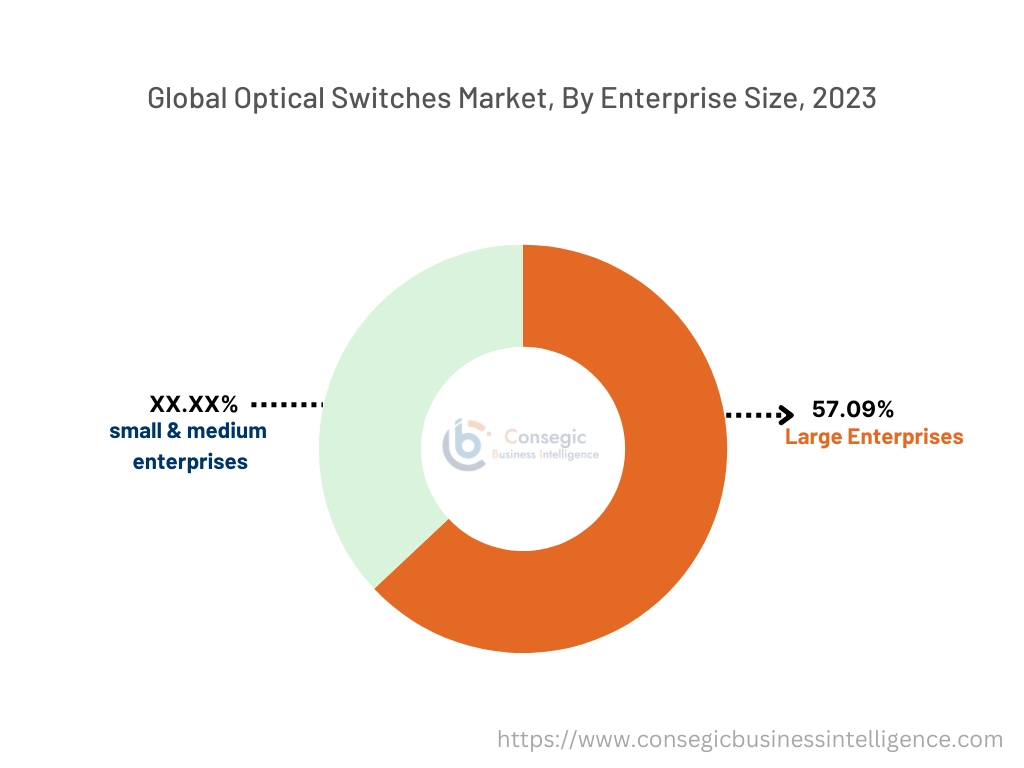
By Application:
Based on application, the market is segmented into switching functions, network monitoring, multiplexing, testing, optical cross-connection, and others.
Trends in the application
- The shift towards energy-efficient technologies used in data centers and others is driving the global optical switches market expansion.
- The switches facilitate high speed data transmission with low latency and have the ability to handle huge data flow in various applications is driving the need for cloud computing and more.
Texting accounted for the largest revenue share in the year 2023.
- The increasing need for quality control and high-performance evaluation is driving the need for OS for testing applications. Moreover, they have the ability to provide and assess signal integrity, bandwidth performance, and system reliability.
- Additionally, industries such as retail, manufacturing, defense, telecom, and BFSI rely on optical switching testing applications for checking the optical computing and fiber optic communication network.
- In August 2022, Yokogawa Test & Measurement Corporation launched an optical time domain reflectometer (OTDR) and AQ3550 optical switch box for high-performance fiber optic testing. The test instrument is ideal for the optical fiber and cable evaluation process.
- Thus, the need for quality assurance and enhanced performance is driving the progress of testing applications in optical switches market trends.
The multiplexing is anticipated to register the fastest CAGR during the forecast period.
- The multiplexing technique is crucial for telecom, data centers, metro networks, and long-haul transmission among others which in turn boosts the evolution of the segment.
- Additionally, multiplexing enables efficient data transmission over optical fiber making it preferable for optimizing network performance, scalability, and cost-effectiveness.
- Further, the growth of 5G and IoT devices is expected to increase the need for efficient data transmission to maximize network efficiency and scalability.
- In September 2023, Sumitomo Electric achieved a milestone of multiplexing 10G-EPON communication system and ICE-X coherent communication which is an Ethernet switch by using a single core Bi-directional optical fiber network.
- Therefore, as per the analysis, the evolution of 5G and IoT devices is anticipated to boost the multiplexing segment which in turn drives the optical switches industry during the forecast period.
By End-Use:
Based on the end use, the market is segmented into IT and telecom, manufacturing, retail, BFSI, military and defense, and others.
Trends in the end-use :
- Advanced driver-assistance systems utilize optical switching technology due to the emergence of IoT and smart manufacturing in the automotive sector.
- The increasing adoption of advanced imaging technology requires high speed data transfer and connectivity is driving the adoption of medical imaging.
The IT and telecom sector accounted for the largest revenue share of 33.45% in the year 2023 and is anticipated to register the fastest CAGR during the forecast period.
- The expanding adoption of 5G networks and cloud computing is propelling the evolution of the IT and Telecom industry which in turn drives market growth.
- The OS has the ability to handle vast amounts of data traffic by facilitating high-speed data transfer and seamless connectivity between connected devices. Moreover, the proliferation of IoT devices is spurring the market need in the IT and telecom industry.
- In June 2024, Constl deployed Ciena’s 6500 Packet-Optical Platform, powered by WaveLogic 5 Extreme (WL5e), optical technology to offer high-speed metro area network and national long-distance connectivity across India.
- Thus, the ability to handle vast amounts of data traffic as well as the development of IoT devices is driving the market demand in the IT and telecom sector.
Regional Analysis:
The regions covered are North America, Europe, Asia Pacific, the Middle East and Africa, and Latin America.
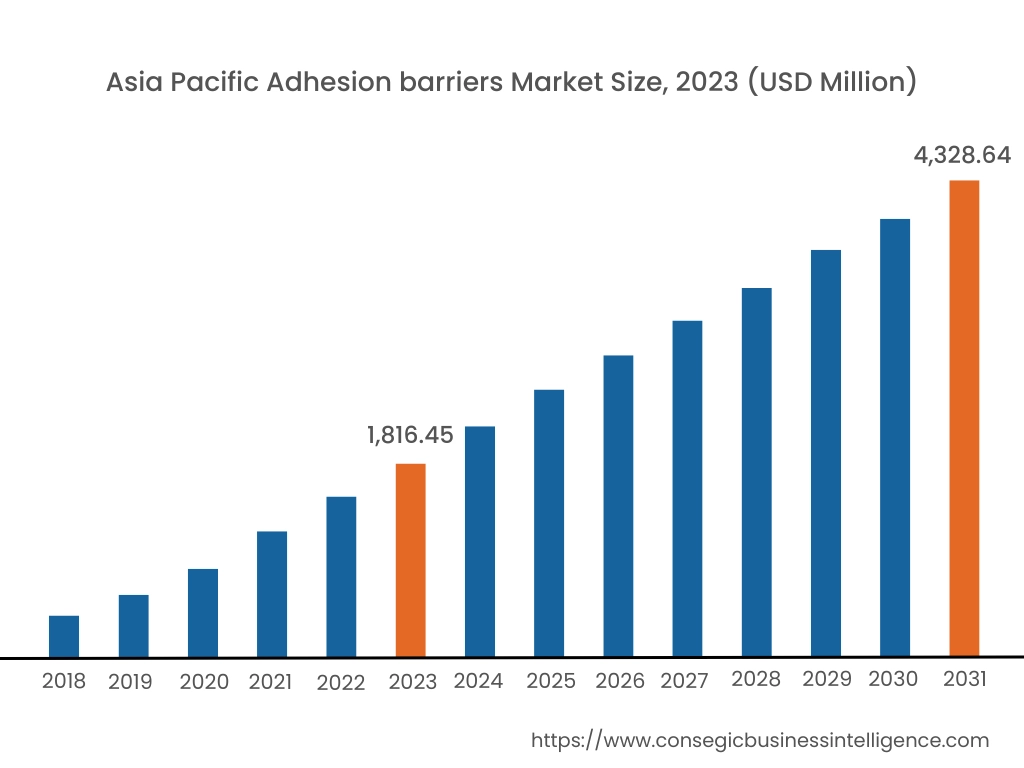
Asia Pacific region was valued at USD 1,816.45 Million in 2023. Moreover, it is projected to grow by USD 1,990.42 Million in 2024 and reach over USD 4,328.64 Million by 2031. Out of this, China accounted for the maximum revenue share of 31.2%. As per the optical switches market analysis, the surge in the need for high bandwidth and data transfer rates as well as the reduction of energy consumption is boosting the need for optical switches market growth in Asia Pacific. Moreover, the rising adoption of smart appliances, IoT devices, and connected homes is growing the optical switches market size.
- In February 2022, Ekinops partnered with Fujitsu by integrating the Ekinops OTN compact modular switch into Fujitsu 1FINITY's open optical networking portfolio.
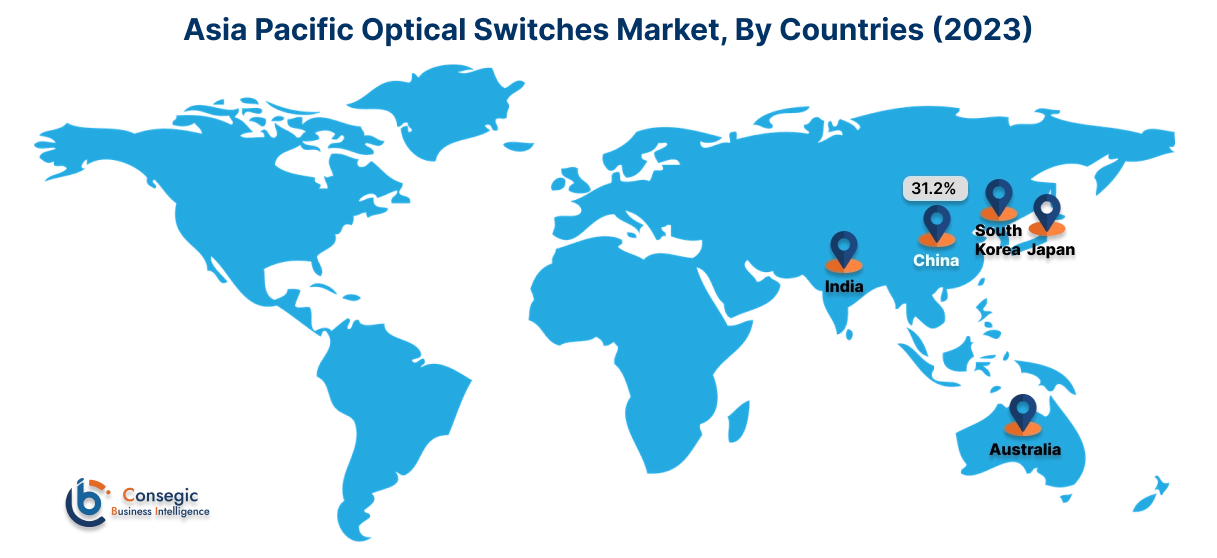
North America is estimated to reach over USD 4,408.40 Million by 2031 from a value of USD 1,890.06 Million in 2023 and is projected to grow by USD 2,067.34 Million in 2024. The growing requirement to route traffic between large internet and cloud networks is driving the optical switches market opportunity in North America. Moreover, the increasing need for automating, scaling, and managing high speed bandwidth with low latency is boosting the optical switches market growth.
- In June 2023, Lumen Technologies collaborated with Google and Microsoft to develop ExaSwitch which is a new network interconnection ecosystem. The ExaSwitch uses optical switching to establish high-capacity optical links between metro sites.
The regional trends analysis depicts that the rising need for enhancing telecom infrastructure as well as digitalization and rising adoption of advanced technologies such as IoT and AI is driving the market in Europe. Moreover, according to the optical switches market analysis, the primary factor driving the market in the Middle East and African region is the rising requirement for data centers and automation in various sectors. Further, the rise in cloud computing, 5G network development, and the need for data transmission is fueling the optical switches market share in the Latin America region.
Top Key Players & Market Share Insights:
The optical switches market is highly competitive with major players providing switches to the national and international markets. Key players are adopting several strategies in research and development (R&D), product innovation, and end-user launches to hold a strong position in the optical switches market. Key players in the optical switches industry include-
-
- Huawei Technologies Co., Ltd. (China)
- NTT Advance Technology Corporation (Tokyo)
- Keysight Technologies Inc. (U.S)
- Furukawa Technologies Inc. (Japan)
- Juniper Networks (U.S)
- Agiltron Inc. (U.S)
- Cisco Systems Inc (U.S)
- Broadcom Inc (U.S)
- Fujitsu Ltd. (Japan)
- Nokia Corporation (Finland)
Recent Industry Developments :
Product launches
- In March 2024, Coherent Corp launched a new optical circuit switch (OCS). The OCS is designed to reduce the number of electric switches used in the data center network as well as reduce the cost associated with electrical-to-electrical conversion required in electric switches.
- In March 2024, Broadcom Inc. launched Bailly, which is a co-packaged optics switch platform that is designed to integrate easily with StrataXGS Tomahawk5 switch chip and offer 51.2 Tbps speed.
Mergers & Acquisitions
- In October 2024, Celestial AI acquired a silicon photonics portfolio. The acquired portfolio includes issued and pending patents and comprises the technology categories of optoelectronic systems-in-package, electro-absorption modulators, and optical switch technology.
- In June 2024, Nokia acquired Infinera to scale up the optical network and increase in-house technology capability in North America. The acquisition is valued at USD 2.3 Million.
Optical Switches Market Report Insights :
| Report Attributes | Report Details |
| Study Timeline | 2018-2031 |
| Market Size in 2031 | USD 1,140.83 Million |
| CAGR (2024-2031) | 6.1 % |
| By Type |
|
| By Enterprise Size |
|
| By Application |
|
| By End-Use |
|
| By Region |
|
| Key Players |
|
| North America | U.S. Canada Mexico |
| Europe | U.K. Germany France Spain Italy Russia Benelux Rest of Europe |
| APAC | China South Korea Japan India Australia ASEAN Rest of Asia-Pacific |
| Middle East and Africa | GCC Turkey South Africa Rest of MEA |
| LATAM | Brazil Argentina Chile Rest of LATAM |
| Report Coverage |
|
Key Questions Answered in the Report
How big is the optical switches market? +
The Optical Switches Market size is estimated to reach over USD 14,501.32 Million by 2031 from a value of USD 6,224.80 Million in 2023 and is projected to grow by USD 6,807.98 Million in 2024, growing at a CAGR of 11.2% from 2023 to 2031.
What specific segmentation details are covered in the optical switches report? +
The optical switches report includes specific segmentation details for type, enterprise size, application, end-use, and regions.
Which is the fastest segment anticipated to impact the market growth? +
In the optical switches market, the MEMS optical switches segment is the fastest-growing segment during the forecast period due to the rising demand for automation and digital transformations as well as the reduced size of MEMS optical switches is driving the growth of the segment.
Who are the major players in the optical switches market? +
The key participants in the optical switches market are Huawei Technologies Co., Ltd. (China), NTT Advance Technology Corporation (Tokyo), Agiltron Inc. (U.S), Cisco Systems Inc. (U.S), Broadcom Inc. (U.S), Fujitsu Ltd. (Japan), Nokia Corporation (Finland), Keysight Technologies Inc. (U.S), Furukawa Technologies Inc. (Japan), Juniper Networks (U.S) and others.
What are the key trends in the optical switches Market? +
The optical switches market is being shaped by several key trends including rising demand for high bandwidth particularly in smart devices, IoT-connected devices, and cloud computing as well as the proliferation of optical switches in advance driving assistance systems are the key trends driving the market.
